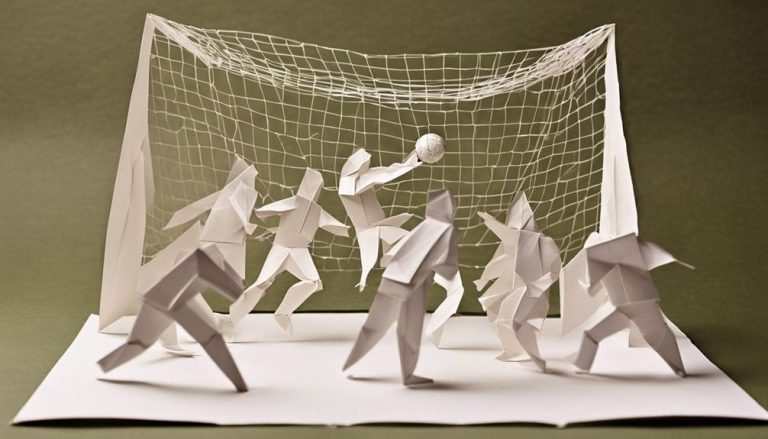General Rules of Log Rolling
Imagine standing on a sturdy log, surrounded by water, preparing to start on the challenge of log rolling. To master this art, you must understand the general rules that govern this unique sport. Safety gear, log selection, foot positioning, balance techniques, rolling direction, competition rules, and practice tips are all important aspects to think about. Each element plays an essential role in your success on the log. But what exactly do these rules entail, and how can they help you navigate the waters of log rolling skillfully and confidently?
Safety Gear
When log rolling, wearing the appropriate safety gear is essential for preventing injuries and ensuring a secure experience. To begin with, helmet requirements are a critical aspect of safety gear when engaging in log rolling. A sturdy helmet that fits properly can protect your head from potential impacts with the log or the water, decreasing the risk of head injuries greatly. Make sure the helmet meets safety standards and is designed for water sports to guarantee excellent protection.
In addition to helmets, there are other protective gear items that can contribute to injury prevention during log rolling. Wearing non-slip water shoes can help you maintain your footing on the log, reducing the likelihood of slipping and falling. Moreover, considering the fast-paced nature of log rolling, it's advisable to wear snug-fitting clothing that won't hinder your movements. Loose clothing can get caught or tangled, increasing the risk of accidents.
When it comes to safety precautions, always ensure that your safety gear is in good condition before stepping onto the log. Check for any signs of wear and tear, and replace any damaged gear promptly. Remember, the goal of wearing safety gear is not just to follow regulations but to safeguard yourself during this exhilarating activity. By prioritizing safety through the use of proper safety gear, you can enjoy the thrill of log rolling with peace of mind.
Log Selection
Before stepping onto the log, selecting the right type of log for your log rolling activity is essential to guarantee a safe and enjoyable experience. When choosing a log, confirm the tree species it comes from and also, it can support the weight limit of the participants. Different tree species have varying wood densities, affecting their buoyancy and stability on the water. Generally, hardwood logs like oak or hickory are preferred for their durability and ability to withstand the rigors of log rolling.
In addition to tree species, the size of the log is another critical factor to take into account. The log should be of adequate diameter and length to provide a stable platform for rolling. A larger log offers more surface area, making it easier to balance on. However, it's essential to ensure that the log is not too large, as this can increase the level of difficulty in spinning and maneuvering.
Furthermore, the water depth where you plan to roll the log is key. The water should be deep enough to allow the log to float freely without touching the bottom. Shallow water can hinder the log's movement and increase the risk of injuries. Opt for water that is at least waist-deep to make sure a smooth rolling experience. By carefully taking into account tree species, weight limits, log size, and water depth, you can select the perfect log for an exhilarating log rolling adventure.
Foot Positioning
When it comes to log rolling, your foot positioning is important. Proper foot placement guarantees balance and stability on the log. Quick adjustments with your feet can make all the difference in maintaining control and outmaneuvering your opponent.
Proper Foot Placement
For successful log rolling, ensuring proper foot placement is essential to maintain balance and control on the log. Proper form and footwork drills are crucial to mastering this skill. Your feet should be shoulder-width apart, with one foot slightly in front of the other to maintain stability. Here is a simple guide to help you position your feet correctly on the log:
| Left Foot | Center | Right Foot |
|---|---|---|
| Slightly in front | Centered | Slightly behind |
| Distribute weight evenly | Pivot point | Distribute weight evenly |
| Helps with forward motion | Balance and stability | Helps with backward motion |
Balance and Stability
To maintain your balance and stability on the log while focusing on foot positioning, it is important to make sure your weight distribution is even and your feet are positioned correctly. Improving technique in log rolling involves having a solid foundation through proper foot placement. Ensuring that your feet are shoulder-width apart and parallel to the log will give you a stable base. By engaging your core muscles, you can enhance your balance and stability even further. The benefits of core strength are essential in log rolling, as they help you stay centered and in control. Remember, the key to mastering log rolling lies in maintaining a strong and balanced stance, which begins with precise foot positioning.
Quick Foot Adjustments
In the art of log rolling, adept foot positioning is essential for maintaining balance and executing quick adjustments on the log. To enhance your skills in this area, consider the following tips:
- Speed control: Practice agility drills to improve your ability to move your feet swiftly and maintain balance even during rapid log spinning.
- Precision: Focus on placing your feet precisely on the log to maximize stability and reduce the risk of slipping.
- Quick reactions: Train yourself to react promptly to changes in the log's movement, adjusting your foot positioning accordingly.
- Consistent practice: Regularly engage in footwork exercises to build muscle memory and improve your overall agility on the log.
Mastering these techniques will help you become more confident and skilled in the art of log rolling.
Balance Techniques
When it comes to mastering log rolling, focusing on balance techniques is key. You'll want to pay attention to body positioning tips and nail down your footwork for stability. These points will help you stay on top of the log and outlast your opponent.
Body Positioning Tips
Engage your core muscles and maintain a low center of gravity to enhance your balance when log rolling. To further improve your body positioning and stability, consider the following tips:
- Keep Your Eyes on the Opponent: Focus on your competitor's movements to anticipate shifts in the log's momentum.
- Relax Your Shoulders: Tension can hinder your balance; keep your shoulders loose and aligned with your hips.
- Bend Your Knees: Flexing your knees slightly helps absorb the log's movements and keeps you agile.
- Use Your Arms for Balance: Utilize your arms to counterbalance and adjust your position as needed.
Footwork for Stability
To enhance your stability on the log, focus on mastering your footwork techniques for the best balance. Proper weight distribution is key to staying centered on the log. Keep your weight evenly distributed between both feet, adjusting as needed to counter the log's movements. Refining your technique will help you react quickly and stay on top of the rolling log. Additionally, building core strength through targeted exercises will improve your balance and stability. Engage in agility training to enhance your ability to shift your weight swiftly and maintain control. By honing your footwork skills, you'll be better equipped to handle the challenges of log rolling with finesse and confidence.
Rolling Direction
Rolling smoothly and swiftly in the correct direction is important for mastering the art of log rolling. To excel in this skill, consider the following tips:
- Focus on Technique: The direction in which you roll can have a major impact on your performance. By practicing rolling in both directions, you can improve your overall technique and gain a competitive advantage over those who only focus on one direction.
- Enhance Skill Development: Rolling in different directions helps in developing a well-rounded skill set. It challenges your balance, agility, and coordination, providing you with a strategic advantage when facing opponents who may only be proficient in one direction.
- Increase Adaptability: Mastering both directions increases your adaptability during competitions. You'll be able to quickly adjust your strategy based on your opponent's movements, giving you an edge in unpredictable situations.
- Confidence Boost: Being proficient in rolling in all directions boosts your confidence on the log. You'll feel more in control, allowing you to focus on outmaneuvering your competition rather than worrying about your own abilities.
Competition Rules
When entering a log rolling competition, understanding the specific rules and guidelines is paramount for a successful performance. Competitions follow strict judging criteria and a clear scoring system to determine the winners. Judging criteria typically include factors such as balance, agility, control, and strategy. It's pivotal to showcase a combination of these skills to impress the judges and secure a higher score.
In log rolling competitions, referee decisions play a pivotal role in ensuring fair play. Referees are responsible for enforcing the rules consistently and making impartial judgments during the matches. Their decisions can have a significant impact on the outcome of a competition, so it's crucial to respect their authority and accept their rulings gracefully.
Rule enforcement is another critical aspect of log rolling competitions. Competitors must adhere to the established rules at all times to avoid penalties or disqualification. Understanding the rules thoroughly before the competition and practicing within those guidelines can help prevent unnecessary infractions during the event.
Practice Tips
For effective improvement in log rolling skills, incorporating structured practice routines is essential to enhance your performance. To help you develop your skills effectively, here are some practice tips you might want to contemplate:
- Practice Drills: Engage in specific drills that focus on different aspects of log rolling, such as footwork, balance, speed, and agility. By targeting these areas individually, you can improve your overall performance more efficiently.
- Consistent Training: Dedicate regular time to practice log rolling to build muscle memory and improve your reflexes on the log. Consistency is key to developing your skills and maintaining progress over time.
- Seek Feedback: Ask for feedback from experienced log rollers or coaches to identify areas for improvement. Constructive criticism can help you understand your weaknesses and work on them effectively.
- Set Goals: Establish clear goals for your skill development in log rolling. Whether you aim to master a specific move or increase your endurance, setting achievable goals can motivate you to push yourself further in practice sessions.
Frequently Asked Questions
What Is the History of Log Rolling and How Did It Become a Popular Sport?
Imagine pioneers in river towns, balancing on rolling logs to prove their strength and agility. This daring feat evolved into a global sport, showcasing cultural traditions and future trends in competitive log rolling.
Are There Any Specific Exercises or Drills That Can Help Improve Balance and Agility for Log Rolling?
To enhance your log rolling skills, focus on balance drills and agility exercises. Coordination training and strength conditioning are key. Practice drills like standing on one leg, jumping side to side, and core exercises for improved performance.
How Does the Weight and Size of the Log Affect the Difficulty Level of Log Rolling?
When the log's weight increases, the challenge of maintaining balance amplifies. A larger log demands more strength and control. Size impacts the speed and responsiveness required for successful log rolling. Embrace the challenge!
Are There Any Specific Strategies or Tactics That Experienced Log Rollers Use to Gain an Advantage in Competition?
When it comes to log rolling competitions, experienced rollers rely on a variety of strategies and techniques to gain an advantage. These can include footwork precision, balance adjustments, quick reactions, and mind games.
Can Log Rolling Be Practiced in Any Type of Water Environment, or Are There Specific Conditions That Are Ideal for the Sport?
Imagine a dance where the water dictates your moves. Log rolling thrives in varied waters. Water temperature matters for safety. Skill level blooms in calm pools to wild rapids. Respect the flow.






